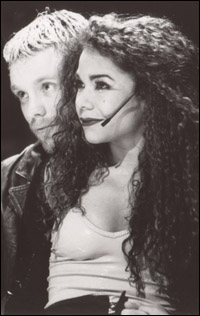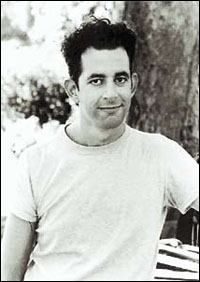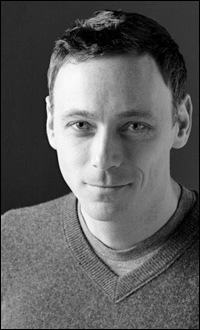
*
Were he alive today, composer-lyricist-librettist Jonathan Larson would be 51 years old and quite possibly the Broadway hit-smith he always dreamed of being. It was a dream denied him. He died Jan. 25, 1996, of an undiagnosed aortic aneurysm only hours after Rent's dress rehearsal at Off-Broadway's New York Theatre Workshop.
Perhaps he had intimations of what the next night would bring, if only a glimmer of the greatness because the pre-opening buzz was certainly pronounced enough and he found himself already giving an interview to The New York Times on the eve of his debut (never a bad sign). Only blue skies should he have seen, one would hope.
The show's arrival and his shocking departure created an intensive box-office bonfire, lighting the way for a trio of adventurous producers (Kevin McCollum, Jeffrey Seller and Allan Gordon) to take the show to Broadway, where it stayed for 1,517 performances and became Broadway's seventh longest-running musical. Three years ago Rent went into R&R (and road companies), but now it's back — at slightly reduced prices — where it began: Off-Broadway, at New World Stages. The official opening is Aug. 11.
Director Michael Greif, its original Tony-nominated skipper, is at the helm again. He discusses what it is like to revisit this primal place in his career.
 |
||
| Adam Pascal and Daphne Rubin-Vega in the original Broadway production of Rent. |
||
| photo by Joan Marcus |
Michael Greif: I'm a different person now, so I have a very different picture of it, sure. I mean, when we were putting it together for the first time, we were discovering what it was while we were doing it. I think now we have some sense of what it is. Others have some sense of what it is. The expectations are quite different. So it's a very different experience than building it the first time and now reviving it.
With Jonathan's presence and even after his terrible, tragic passing, we were still juggling material and moving things around and finding out where things landed best. So that experience isn't a part of what we're doing. We know what the material is. We have, I think, great confidence and affection for what the material is.
What's been very interesting, of course, is sharing what life in the late '80s-early '90s in the East Village was like with this new company. Y'know, the environment that inspired Jonathan to write this piece was a very different environment than New York is now so there was a lot of information-sharing and story-telling going on, just about what it was like in those days — what a positive HIV-status meant in those days, which is different from what it might mean now — what the Lower East Side and Village were like, who lived there, who squatted there — what the music scene was. There was a lot of that.
Has the material varied much from its original starting place?
MG: I was brought into the project in early '94 in order to do a workshop in the fall of '94. I was the first person to direct it. There had been a reading of it a few months earlier at New York Theatre Workshop that Jim [NYTW artistic director James C. Nicola] felt strongly enough to want to continue encouraging Jonathan to work on it.
I [read] material much of which is very much the same material that's here now. Most of the Roger and Mimi material that I read in 1994 stays just the same. In some cases, there are little trims. Other parts of the play, especially the Maureen and Joanne material, Jonathan continued to work on all through our rehearsals in '95. Their "Take Me or Leave Me" was the last song Jonathan wrote for Rent.
 |
||
| Jonathan Larson |
MG: Textually? Textually, it's very much the same, with a few little tucks. No additions. No updates. It's set in the period, and I think that that's very important to the period. The psychologies of the characters are very true to that time.
I think an audience always has to open their hearts to these characters, and I think the reason why they do is because they see the urgency with which these characters are living and they see that mortality is really looking right in their young faces.
The nice thing about reviving a show is that you can rethink it. Have you been rethinking this a while?
MG: Yes, actually. When we made the original move from Off-Broadway to Broadway, I had very naively imagined that there would be time to reconceive the show for the Nederlander, and in fact there wasn't. We did very much the same show on Broadway that we did at the New York Theatre Workshop.
When Jeffrey and Kevin and Allan called about the possibility about reviving the play — which was certainly something that I had been thinking about — I quickly asked if they could imagine a new physical production for the play. I let them know I would be very excited to work on a newly conceived physical production, and they found that idea interesting.
It's been unusual and even odd to go back, I have to say. I mean, I had gone back to it over the years. I spent a lot of time with the Broadway company when it was closing, Adam [Pascal] and Anthony [Rapp] came back and did a tour right after Broadway closed, so it hasn't been very long since I looked into it. New sets, new costumes, new choreography, new projection design — all that points you in a new direction.
What were the projections before?
MG: Wonderful Tony Gerber did films that the character Mark supposedly had done with his camcorder so there was some film in the finale and in what we called "tune-up finale," but I think now they'll be a more on-going presence and that we'll visually feature more of a through-line of Mark being a filmmaker in a more successful way.
 |
||
| Choreographer Larry Keigwin |
MG: I think it's a very, very hospitable environment for us. I went and visited the theatre. I thought the theatre would be terrific for it. Mark Wendland is the set designer now. Paul Clay was our original set designer. He was a wonderful visual artist. How will this be physically reconceived?
MG: Fully. I will say it is fully re-conceived. The space is not smaller. I think the proscenium opening at New World Stages is pretty much the proscenium opening at the Nederlander. Not so much smaller. It's a wide space. We certainly don't have as much height as we did at the Nederlander, but we're trying to indicate height in different ways.
Your new choreographer, Larry Keigwin, does he come to you with his ideas, and do you, in turn, have suggestions for him?
MG: Yes to both. I think Larry is being very generous about recognizing my history with the piece. In many ways, we talk about the conceptualization of what the movement is and what the numbers need to say — y'know, the dramatic and narrative functions of the dances. In some ways, I set things up, and then he gets to conceive and choreograph himself. I think he is doing a really spectacular job.
Angel Wendt, who designed the original costumes, is making new costumes. Our lighting designer is Kevin Adams, and Peter Negrini is media projections designer.
Blake Burba was our original lighting designer, very sensitive to music in the way that Kevin [Adams] is. Because the physical production is different, the lights will be different. There are certain things that might be staged very similarly. At the moment, I think "Seasons of Love" will be staged like it's been staged in the past. I suspect that means that in order to get lights on those characters there'll be some similar lighting. On the other hand, I have complete confidence that Kevin, who's a great artist, will respond individually to the event and to the music and will build something that's his own.
Do you love this gift of getting to come back and do this all over again?
MG: I do. I love the idea of the live show being in New York again. It's been sad not to have the show running. I love the fact that all these young cast members saw the show throughout its life on Broadway. They all talked about the extraordinary meaning that Jonathan's work had on them. "It was the first show I saw" or "It really synthesized all the things I love" or "I could imagine myself being a performer because of seeing those performers." That's quite a legacy.
MG: It's an extraordinary legacy. Besides the legacy to so many performers, there are the composers and lyricists and book-writers. Every young composer-lyricist, I think, will talk about Jonathan's influence on them. And so many of these performers we cast spoke about how meaningful this musical was to them and how it steered them to their life choices.
I love having Jonathan's work out there again live for more young people to see. And there have been so many extraordinary pieces of theatre that followed Rent where you can see a real kinship.
(Harry Haun is a longtime staff writer for Playbill magazine and pens Playbill.com's On Opening Night columns.)










